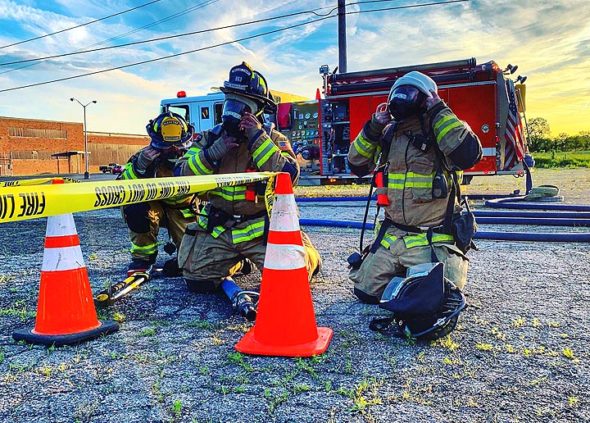
Casey Brewer, who first came to Miami Township Fire-Rescue in 2013 as a member of the Explorer Post for teens, took this photo at a recent training event and shared it on the MTFR Facebook page. Brewer, 19, recently received EMT certification, Chief Colin Altman reported at the Miami Township Trustees’ most recent meeting Monday, July 1. (Submitted photo by Casey Brewer)
Fire, EMS calls on the rise
- Published: July 11, 2019
Crew members of Miami Township Fire-Rescue are responding to more emergency calls than ever before, according to statistics recently released by the department.
In the department’s annual report for 2018, presented to Miami Township Trustees at their June 17 meeting, the number of dispatched incidents were shown to have risen steadily from 814 in 2013, the earliest year listed, to 1,081 last year.
As for 2019, fire Chief Colin Altman told trustees that the incident number is “on target to be 1,200 this year.”
A small part of that increase is related to the expansion of the department’s geographical coverage area late last year to include eastern Bath Township, in addition to Miami Township and the villages of Yellow Springs and Clifton.
As of June 1, MTFR had responded to 45 incidents in Bath Township, according to Altman.
All told, about 7,500 area residents fall under MTFR’s care.
Runs for 2018, generated by both calls through dispatch and directly to the station, totaled 1,128. Of those, 874 were for emergency medical service, or EMS, and 254 were fire related.
Township Trustee Don Hollister noted that 874 ambulance runs represented an average of 2.5 a day.
Altman said that the local department’s larger EMS load reflects a national trend among smaller municipalities.
“Most places are EMS departments that happen to fight fires,” he said.
According to the 2018 annual report, the department attended to 763 patients, 184 of whom were treated and released. More than 560 patients were transported to area hospitals, while 17 calls involved a death. The average patient age was 54, according to department records.
The EMS calls, broken down by percentage, were 41% medical, 17% trauma, 11% cardiac, 13% mental health, 10% fire standby and 8% other.
According to Altman, the number of local mental health calls is significantly higher then elsewhere in southwest Ohio, where the average is 4% of EMS calls.
Ambulance response time, calculated from dispatch to arrival, averaged 6.3 minutes, according to the 2018 report.
“Which isn’t bad, when we’re covering 32 square miles,” Altman commented.
The fire-incident call break down included 29% accompanying rescue/EMS, 28% false alarms, 16% hazardous conditions and 7% actual fires.
One fire-related death occurred in 2018, while monetary losses due to fire totaled $404,160 in 2018, according to the report.
Engine response time averaged seven minutes.
While the incident numbers have increased, the department has “evolved as an agency,” Altman said in an interview this spring.
The department’s makeup today is very different from the one Altman joined in 1994, when MTFR had two paid employees and “close to 45 to 50 volunteers answering about 500 calls a year,” he said.
Today, MTFR is comprised of a combination of full-time and part-time paid staff working alongside a couple dozen volunteers.
As of Dec. 31, 2018, the department had 34 members — five full-time, including the chief and Assistant Chief Denny Powell; eight part-time; and 21 volunteers. A sixth full-time position of lieutenant was added this year, when Joe Panuto was promoted.
At least two people are on duty at the firehouse at all times, with shifts of eight to 24 hours. Volunteers are asked to commit to at least 36 scheduled hours a month, Altman said.
Most MTFR members are both fire fighters and EMT, or paramedics. And some of the department’s volunteers have been with MTFR for “12, 15, 17 years,” Altman said.
But while they have a dedicated, loyal crew, they still have difficulty attracting enough volunteers, he added.
One obstacle is the time needed to fulfill all the training that is required.
Altman said that when he started, new crew members had to take a 36-hour fire class, and EMT work required a 120-hour class. Today, the entry-level fire course is 178 hours, and EMT training requires 200 hours.
“That’s just to get started,” he said.
Continuing training is ongoing. Last weekend, for example, a group participated in a ropes and rescue course, Altman told trustees at their most recent meeting, July 1.
Volunteers don’t have to live in the village or township, but the department needs more people to live close by, Altman said, telling the township trustees last month that some potential crew members “can’t afford to live here.”
While the 2018 annual reported noted that the department had recruited seven new volunteers last year, Altman said more are wanted, especially as the demand for service continues to rise.
The Yellow Springs News encourages respectful discussion of this article.
You must login to post a comment.
Don't have a login? Register for a free YSNews.com account.













No comments yet for this article.